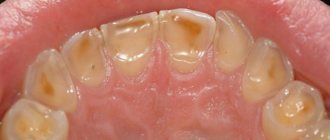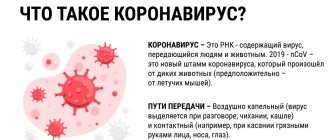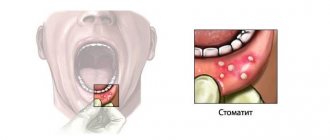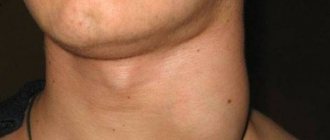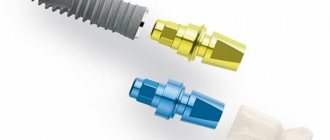604
It is not at all difficult to imagine a person who, in his entire life, has never suffered from, say, heart or kidney disease.
But it is unlikely that there will be an individual who, throughout his entire life, has never experienced problems with his teeth, has not suffered from pain, or has not sought the help of a dentist, surgeon, orthopedist or orthodontist.
Bad teeth are incompatible with a high quality of life. Meanwhile, maintaining their health is not so difficult.
Intact – what is it?
What is an intact tooth in dentistry? Translated from Latin, intactus means “untouched.” Accordingly, an intact one is one that is intact, healthy and not affected by any inflammatory processes or diseases. Hearing this term in relation to his teeth after a preventive examination, the patient should rejoice. You can experience twice as many positive emotions if the doctor says that you have an intact dentition, because this means that all the elements in the row are healthy.
Important! The term can be applied not only to the whole tooth, but also to its individual components and structures - enamel, crown, root, periodontal tissue. The doctor may also use a phrase such as intact surface, but this does not mean at all that the tooth is healthy - it may be affected by caries, pulpitis or periodontitis, but at the same time, areas not affected by infection or destructive processes remain.
Rules for maintaining oral health
The main preventive measures against the development of dental diseases are proper oral hygiene and regular visits to the dentist.
Teeth do not become sick instantly. It takes a certain amount of time for an intact unit to become carious or pulpitic.
Regular visits to the dentist once every 3-6 months allow you to promptly notice signs of trouble and take preventive measures to stop the development of the disease.
Demineralization of enamel, the presence of soft and hard plaque, increased tooth abrasion, malocclusion creating periodontal overload - all these signs will be detected by the doctor during examination, and treatment or preventive measures will be prescribed. As a result, the development of an unfavorable situation will be stopped, and the unit will remain intact.
Good oral hygiene is considered the main condition for keeping teeth healthy. Over the past centuries of development of scientific dentistry, the causes and mechanisms of dental diseases have been studied in sufficient detail. It has been established that in most cases, poor oral hygiene is the main cause of dental disease.
Food debris that is not removed from the oral cavity becomes a breeding ground for cariogenic bacteria. Acids produced by microorganisms corrode the enamel, forming a carious cavity, which, spreading deeper and wider, destroys the tooth crown, reaches the pulp chamber and inflames the pulp, leading to the need for depulpation.
The fight against caries and tooth decay should begin with mastering proper oral care. The main goal of hygiene is to prevent the formation of plaque (plaque), which involves regular brushing of teeth with a brush and toothpaste.
Cases in which intact surfaces have to be prepared
Installation of veneers and lumineers
Doctors always resort to preparation of hard tissues before installing prostheses. Even if you are just going to install veneers or ultraneers to hide the unsatisfactory shade of enamel and diastema, you need to be prepared for grinding. The frontal surface, even if it is completely intact, will be subjected to minor preparation. How much fabric will need to be sewn? Everything will depend on the thickness of the lining, approximately 0.3–0.8 mm.
On a note! If you decide to improve the aesthetics of the smile area with the help of artistic restorations with a composite, to hide the diastema (interdental gap), for example, then the doctor will also carry out a minor preparation of the frontal surfaces of the anterior units so that the filling materials fit better to them.
You will have to grind the enamel the least if you choose lumineers. However, the doctor will still have to lightly sand it down to a thickness equal to the thickness of the onlay (about 0.3 mm) to ensure high quality fixation and a natural smile.
Prosthetics with bridges
An intact tooth can act as a support tooth for bridge prosthetics. And before installing the structure, it will have to be very thoroughly prepared; trephination (opening) of the crown will be carried out and the pulp will be removed.
Treatment of pulpitis and periodontitis
The physician may touch an intact surface, such as the palatal surface, when treating pulpitis or periodontitis on incisors or canines in order to provide access to the coronal portion of the pulp and root canal orifices. It is not possible to do this from the front side of the cutting edge, since then there is a risk of spoiling the natural shape, aesthetics and functionality.
Bite correction
It is necessary to touch the intact surfaces of some teeth when carrying out a procedure such as separation (grinding). Most often it is used in orthodontics if the bite pathology is minor. The procedure helps to avoid removing some elements of the row. During the process, the doctor grinds off the enamel from the side surfaces and can free up up to 5 mm of space on the jaw.
Syndrome X in cardiology (“microvascular angina”)
In approximately 10–20% of patients who undergo diagnostic coronary angiography due to acute or chronic cardiac ischemic syndrome, the coronary arteries are intact. Even if we assume that in some of them the symptoms of ischemia may be due to other cardiac and non-cardiac causes, then at least one out of ten patients with typical angina pectoris does not have hemodynamically significant stenoses of the coronary arteries. The presence of typical angina with unchanged coronary arteries was first described by N. Kemp in 1973 [1]. This syndrome is called “ X(X) syndrome” .
Cardiac syndrome X is a pathological condition characterized by the presence of signs of myocardial ischemia in the absence of atherosclerosis of the coronary arteries and spasm of the epicardial coronary arteries on coronary angiography (signs of myocardial ischemia: typical attacks of angina and ST segment depression ≥ 1.5 mm (0.15 mV) duration more than 1 minute established during 48-hour ECG monitoring). Thus, cardiac syndrome X is diagnosed in patients:
• with typical chest pain;
• with positive stress tests;
• with angiographically normal epicardial coronary arteries and no clinical or angiographic evidence of coronary artery spasm;
• with the absence of systemic arterial hypertension with and without left ventricular hypertrophy, as well as the absence of disturbances in the systolic function of the left ventricle at rest.
In rare cases, patients with syndrome X develop left bundle branch block with subsequent development of dilated cardiomyopathy. It should be noted that in the absence of changes in the coronary arteries during angiography, there is often occlusive pathology of the distal vessels (microvascular angina).
Some authors use the term “microvascular angina,” meaning that patients with typical angina have a normal coronary angiogram and reduced coronary reserve.
Syndrome X is usually classified as one of the clinical forms of coronary artery disease, since the concept of “myocardial ischemia” includes all cases of imbalance in oxygen supply and myocardial demand for it, regardless of the reasons causing it.
It should be noted that the capabilities of the angiography method in assessing the state of the coronary bed, in particular microvascular, are limited. Therefore, the concept of “angiographically unchanged coronary arteries” is very arbitrary and indicates only the absence of atherosclerotic plaques narrowing the lumen of the vessels in the epicardial coronary arteries. The anatomical features of the small coronary arteries remain “angiographically invisible.” Causes of cardiac syndrome X:
The etiology of cardiac syndrome X remains unclear and only some pathophysiological mechanisms leading to the development of typical clinical and instrumental manifestations of the disease have been established:
• increased sympathetic activation; • endothelial dysfunction; • structural changes at the microcirculation level; • metabolic changes (hyperkalemia, hyperinsulinemia, “oxidative stress”, etc.); • increased sensitivity to intracardiac pain; • chronic inflammation; • increased stiffness of arteries, etc.
There are a number of hypotheses that determine the pathogenesis of syndrome X. According to the first of them, the disease is caused by myocardial ischemia due to functional or anatomical disorders of microcirculation in intramuscular (intramural) prearterioles and arterioles, i.e. in vessels that cannot be visualized by coronary angiography. The second hypothesis assumes the presence of metabolic disorders leading to disruption of the synthesis of energy substrates in the heart muscle. The third hypothesis suggests that syndrome X occurs with increased sensitivity to painful stimuli (decreased pain threshold at the level of the thalamus) from various organs, including the heart.
Despite intensive research over the past 35 years regarding the pathogenesis of coronary syndrome X, many important questions remain unanswered.
Among patients with cardiac syndrome X, middle-aged people, mostly women, predominate. Less than 50% of patients with cardiac syndrome X have typical exertional angina, and the majority have atypical chest pain. Symptoms of cardiac syndrome X:
The main complaint includes episodes of angina-type chest pain that occurs during physical activity or is provoked by cold or emotional stress; with typical irradiation, in some cases the pain is longer lasting than with ischemic heart disease, and is not always relieved by taking nitroglycerin (in most patients the drug worsens the condition). Symptoms accompanying cardiac syndrome X resemble vegetative-vascular dystonia. Cardiac syndrome X is often found in people who are suspicious, with a high level of anxiety, against the background of depressive and phobic disorders. Suspicion of these conditions requires consultation with a psychiatrist. The diagnostic criteria for cardiac syndrome X include: • typical chest pain and significant depression of the ST segment during physical activity (including on the treadmill and bicycle ergometer); • transient ischemic depression of the ST segment ≥ 1.5 mm (0.15 mV) lasting more than 1 minute during 48-hour ECG monitoring; positive dipyridamole test; • positive ergometrine (ergotavin) test, a decrease in cardiac output against its background; • absence of atherosclerosis of the coronary arteries during coronary angiography; • increased lactate content during ischemia when analyzing blood from the coronary sinus area; • ischemic disorders during stress myocardial scintigraphy with 201 Tl.
Syndrome X resembles stable angina. However, clinical manifestations in patients with syndrome X are very variable, and in addition to exertional angina, attacks of resting angina can also be observed.
When diagnosing cardiac syndrome X, the following should also be excluded: • patients with spasm of the coronary arteries (vasospastic angina), • patients in whom non-cardiac causes of chest pain are documented by objective methods, for example:
- musculoskeletal causes (osteochondrosis of the cervical spine, etc.); — neuropsychic causes (anxiety-depressive syndrome, etc.); - gastrointestinal causes (esophageal spasm, gastroesophageal reflux, gastric or duodenal ulcer, cholecystitis, pancreatitis, etc.); - pulmonary causes (pneumonia, tuberculosis in the lungs, pleural overlays, etc.); - latent infections (syphilis) and rheumatological diseases.
Treatment of cardiac syndrome X:
Treatment for the group of patients with syndrome X remains not fully developed. The choice of treatment is often difficult for both treating physicians and the patients themselves. The success of treatment usually depends on the identification of the pathological mechanism of the disease and is ultimately determined by the participation of the patient himself. An integrated approach to the treatment of patients with cardiac syndrome X is often necessary.
There are various approaches to drug treatment: antianginal drugs, ACE inhibitors, angiotensin II receptor antagonists, statins, psychotropic drugs, etc. Antianginal drugs such as calcium channel blockers (nifedipine, diltiazem, verapamil, amlodipine) and β-adrenergic blockers (atenolol, metoprolol , bisoprolol, nebivolol, etc.) are necessary for patients with documented myocardial ischemia or impaired myocardial perfusion. Sublingual nitrates are effective in 50% of patients with cardiac syndrome X. There is evidence regarding the effectiveness of nicorandil, which has a bradycardic effect, the α1-blocker prazosin, L-arginine, ACE inhibitors (perindopril and enalapril), cytoprotectors (trimetazidine).
General advice on changing quality of life and treating risk factors, especially aggressive lipid-lowering therapy with statins (reducing total cholesterol to 4.5 mmol/l, LDL cholesterol less than 2.5 mmol/l), should be considered as vital components of any chosen treatment strategies.
Physical training. With cardiac syndrome X, tolerance to physical activity decreases, physical detraining and inability to perform exercise are observed due to a low pain threshold. Physical training increases the pain threshold, normalizes endothelial function and “delays” the appearance of pain during exercise in this category of patients.
Forecast.
The prognosis of patients with cardiac syndrome “X” is usually favorable. Complications typical for patients with coronary artery disease with stenotic atherosclerosis of the coronary arteries (in particular, myocardial infarction) are extremely rare. Survival with long-term follow-up is 95–97%, but in the majority of patients, repeated attacks of angina over many years have a negative impact on the quality of life. While not associated with increased mortality or an increased risk of cardiovascular “events,” cardiac syndrome X often seriously impairs patients' quality of life and poses a significant burden to the health care system. It must be emphasized that the prognosis is favorable in the absence of endothelial dysfunction. In these cases, the patient should be informed about the benign course of the disease. When excluding patients with left bundle branch block and patients with secondary microvascular angina due to serious systemic diseases such as amyloidosis or multiple myeloma, the prognosis of patients with cardiac syndrome X is favorable both in terms of survival and preservation of left ventricular function, but in some patients clinical manifestations of the disease persist for quite a long time.
Orthodontic bite correction
There are often clinical cases in which, before treating malocclusions with braces or aligners, some teeth must first be removed. This is done to free up free space on the jaw. In this case, the intact tooth itself may have a normal location, but it has to be sacrificed. Often the third molars are removed, less often the second and first ones.
On a note! The definition of intact is a tooth that is not affected by dental diseases such as caries, pulpitis or periodontitis. However, it may be curved, occupy an incorrect position in the row, be supernumerary, or have signs of macrodentia (crowns that are too large in size) or microdentia (small crowns).
If the unit is intact or has an oversized crown, it will most likely have to be removed before braces can be placed.
Skin types and conditions
The skin is inextricably linked with the vital functions of the whole organism and reflects the state of human health. Intact skin serves as a reliable barrier, protection from harmful environmental influences - temperature, chemical, mechanical and from the introduction of microorganisms. With age, recovery processes worsen and, every year, the skin begins to fade faster, wrinkles appear, and skin color changes. At 20 years old it seems that 30, 40, and even more so 50 years old is somewhere in the sky. This is a common misconception, and only those who start taking care of their skin in time will not be afraid of any anniversaries, maintaining a beautiful complexion and young, elastic skin.
50% of the effectiveness of cosmetics is the correct care that matches your skin type! Another 50% is mandatory monitoring of skin condition, which can change depending on weather conditions, water, how well we slept and even the menu of our dinner the day before. What is skin type? What are the different skin types? And finally, why do you need to know your skin type? The answers to these questions are of great importance for skin care and disease prevention. In cosmetology, there are 4 skin types: normal, combination, oily and dry.
Why remove intact milk units?
This must be done in cases where the time frame for changing milk units to permanent ones is delayed. At the age of 7–8 years, permanent teeth begin to erupt, but temporary teeth should begin to fall out, but not all children have this process smoothly.
It also happens that the dairy ones, due to excessive mineralization or due to the individual characteristics of the body, do not even wobble, although the rudiments of permanent ones are already resting on their roots.
If such elements are not removed in a timely manner, the permanent ones may make their way into the second row. This can cause crowding and malocclusion in adulthood.
Prevention
Many people have at least once in their lives wondered whether it is good or bad to have intact teeth and what it is all about. The presence of such a tooth is a wonderful sign. And you can achieve their presence without any problems if you follow the rules of oral hygiene from childhood.
Theoretically, natural teeth can be kept strong and healthy into old age. But for this they need careful care. Most oral diseases can be prevented by following simple preventive measures.
